Part time job offer letter template
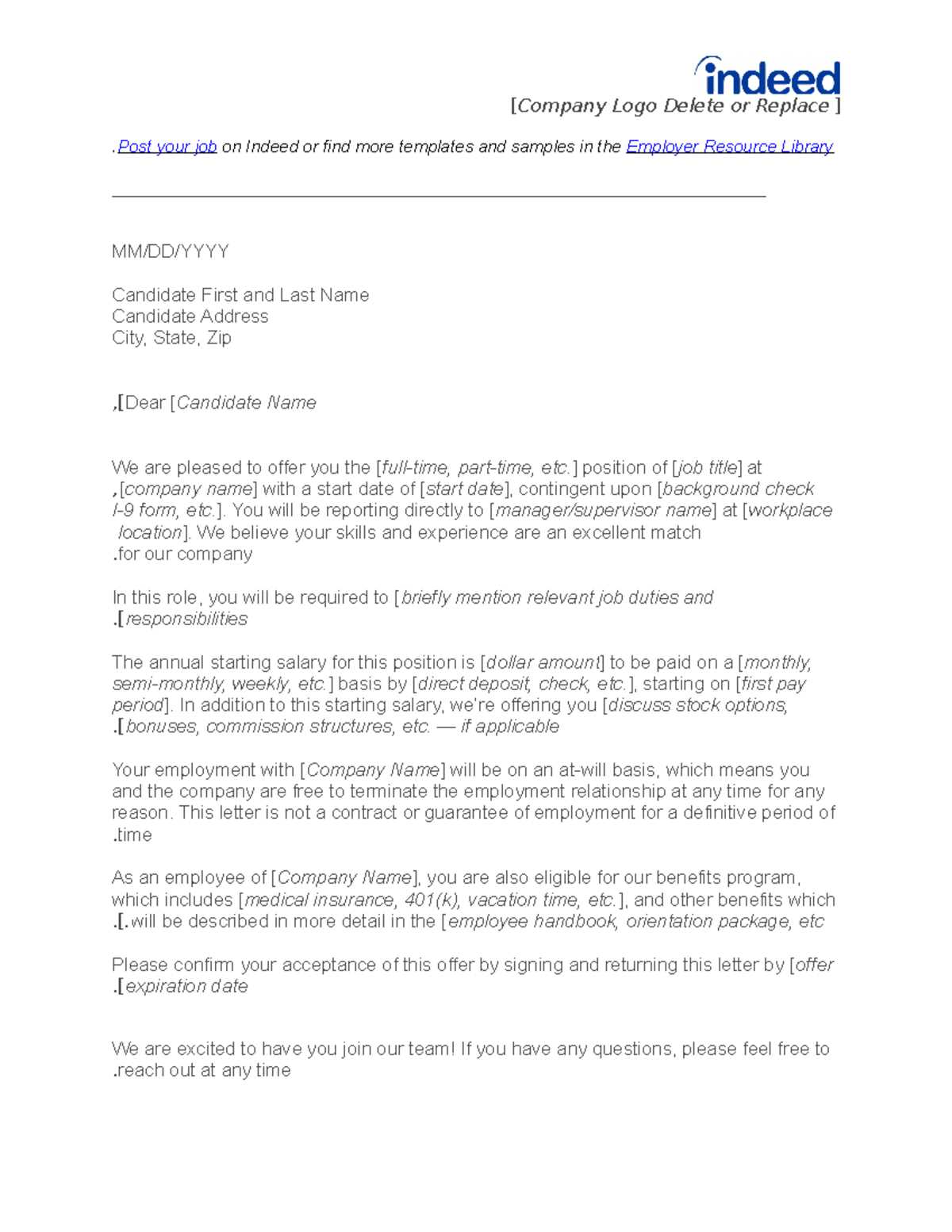
When offering a part-time position, clear communication in the job offer letter is key. A well-structured letter outlines the terms of employment and provides clarity for both parties. It sets expectations and ensures both employer and employee are on the same page from the start.
The letter should start with a formal introduction, addressing the candidate by name and clearly stating the position being offered. Following this, include specific details such as the working hours, pay rate, job responsibilities, and any benefits available. Be sure to also mention the start date and probationary period, if applicable.
It’s also helpful to emphasize any important company policies or expectations that will help the new hire succeed. This might include dress code, attendance, or performance standards. Keep the tone friendly yet professional, ensuring that the candidate feels welcomed and valued.
Make sure the letter closes with clear next steps, such as signing and returning the letter or confirming acceptance of the offer. This gives the candidate a simple way to proceed and confirms their understanding of the job details.
Here are the corrected lines:
To ensure clarity and professionalism in a part-time job offer letter, avoid unnecessary verbosity and ensure that all relevant details are clear. Make sure the tone is inviting yet formal, focusing on specifics.
Job Position
Corrected line: “We are pleased to offer you the position of [Job Title] at [Company Name], effective from [Start Date].” This line clearly specifies the job title and start date without ambiguity.
Working Hours and Pay
Corrected line: “Your weekly working hours will be [X hours], and you will be compensated at a rate of [Amount] per hour.” This revision eliminates any confusion regarding the pay and working hours.
Corrected line: “You will receive payment on a [weekly/bi-weekly/monthly] basis, directly deposited into your account.” Make sure this detail is concise to avoid misunderstandings related to pay schedules.
Conditions of Employment
Corrected line: “This offer is contingent upon the successful completion of [specific requirement, e.g., background check, reference verification].” Be clear about any contingencies that may affect the job offer.
Corrected line: “You will be required to sign an employee agreement outlining the terms and conditions of your employment.” This ensures the candidate understands the commitment needed.
- Part-Time Job Offer Letter Template
A well-crafted part-time job offer letter is a key document for setting clear expectations with a candidate. Below is a concise template that includes all the necessary details. Customize this based on your company’s policies and the role you’re offering.
Job Offer Letter Template
Date: [Insert Date]
Dear [Candidate’s Name],
We are pleased to offer you the position of [Job Title] at [Company Name]. Below are the key details regarding your employment:
- Position: [Job Title]
- Start Date: [Start Date]
- Hourly Wage: [Hourly Rate] per hour
- Work Hours: [Number of hours per week] hours per week
- Work Schedule: [Work Days and Hours]
- Benefits: [List any part-time benefits, such as discounts, or paid time off if applicable]
- Reporting to: [Manager/Supervisor Name]
By accepting this offer, you agree to comply with the company’s policies and procedures. We look forward to having you as part of our team.
Please sign and return a copy of this letter by [Deadline Date] to confirm your acceptance of this offer.
Sincerely,
[Your Name]
[Your Position]
[Company Name]
Signature: ___________________
Date: ___________________
Key Points to Include
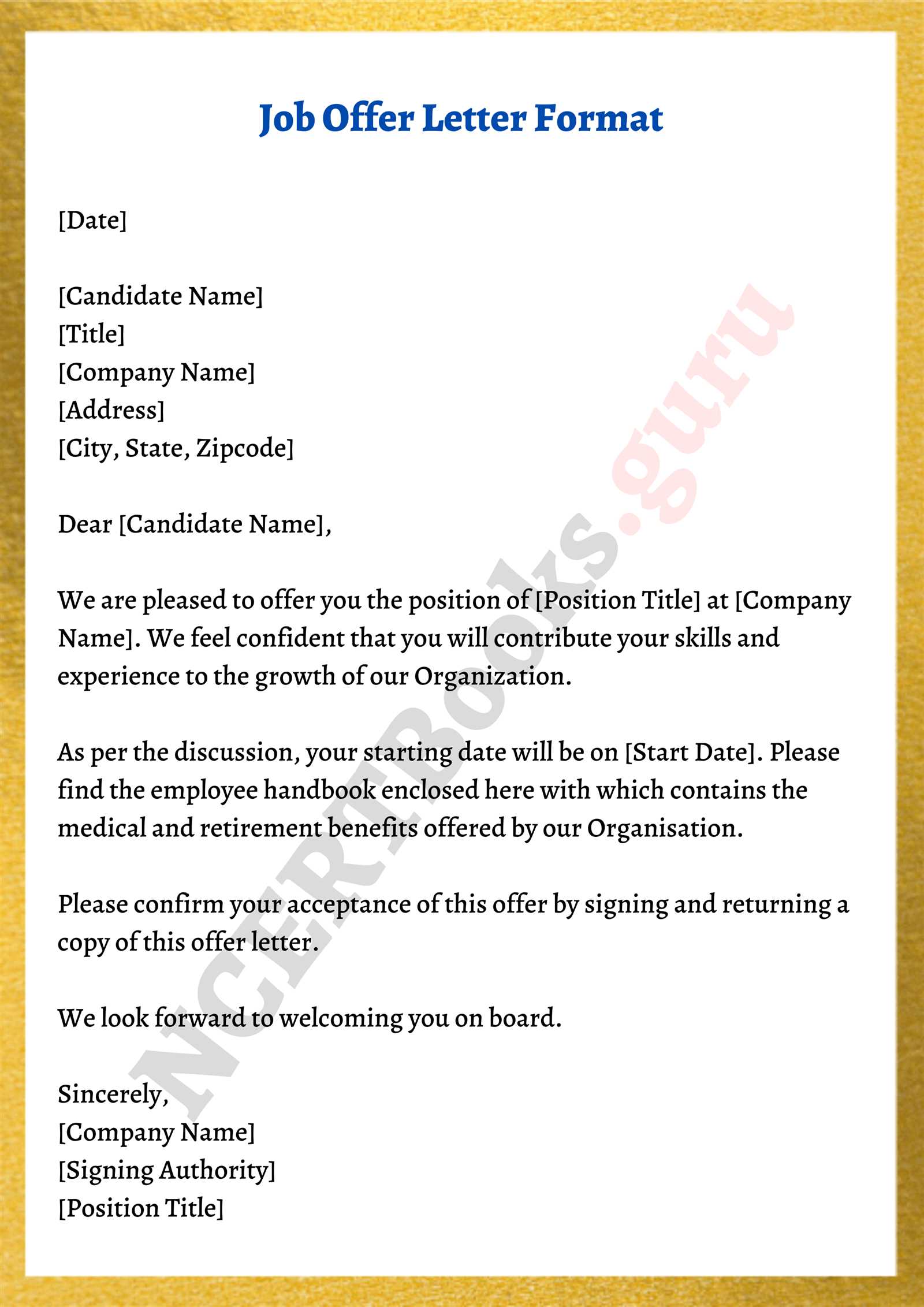
Always ensure you provide essential details such as the position, compensation, and expected hours. Clearly state any deadlines for acceptance and any terms related to the employment agreement. Keeping the tone friendly yet professional fosters a positive relationship from the start.
Key Elements to Include in a Part-Time Job Offer Letter
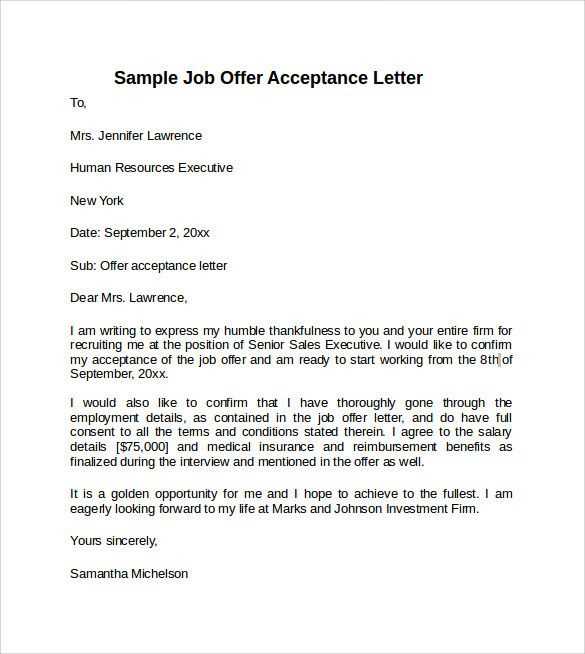
Begin the offer letter by specifying the job title. This provides clarity to the candidate about the position they are being offered. Include the department or team to which they will belong for a better understanding of their role in the organization.
Clearly state the compensation package. This includes the hourly wage or salary, and any additional benefits such as bonuses, commissions, or health insurance. Specify whether the payment is made weekly, bi-weekly, or monthly.
Work Schedule and Expectations
Indicate the work hours or the number of hours per week the candidate is expected to work. If there are any specific shifts or flexible hours, make sure to mention these details. It helps the candidate understand the time commitment required for the role.
Start Date and Duration
Provide the start date for the position. If the job is temporary or project-based, include an end date or a mention of the contract duration. If the position is open-ended, clarify that it is an ongoing part-time role.
Don’t forget to highlight any probationary period, if applicable. Clarify the length and conditions under which the employment may be terminated or extended during this period.
Finally, conclude the offer with a call to action. Ask the candidate to confirm their acceptance of the offer and provide instructions on how to do so, whether by signing and returning the letter or responding by email.
Specify the number of hours expected each week. For example, you can state that the position requires 20 hours per week, or set specific shift times if applicable. Be clear about flexibility–whether the hours are fixed or if the employee can adjust their schedule within certain limits.
Next, outline the compensation. Mention the hourly wage, salary, or other payment structure. If offering an hourly wage, clarify whether overtime pay applies and at what rate. For salaried positions, ensure the annual salary is specified, as well as how frequently payment will occur (e.g., weekly, bi-weekly, monthly).
Also, consider including any benefits or bonuses. For instance, if there are performance-based incentives, explain how they are calculated. Clearly state if the position includes any paid time off (PTO) or other perks.
Clearly outlining the responsibilities in a part-time job offer letter sets clear expectations for both the employer and the candidate. Specify the tasks expected of the employee, the scope of work, and any specific duties that align with the company’s needs. This helps avoid misunderstandings later on.
Be Specific About Daily and Weekly Tasks
Detail the routine tasks, such as customer interaction, product assembly, or data entry. Define the frequency of each responsibility, whether it’s daily, weekly, or as needed. For example, “You will be responsible for managing customer inquiries through email and phone on a daily basis.” This eliminates ambiguity and provides structure.
Clarify Reporting and Expectations
Define who the employee reports to and the expected communication style. Mention specific goals or performance metrics if applicable, such as “You will be expected to complete at least 5 projects per week and provide weekly updates to your supervisor.” This ensures both parties understand how progress will be evaluated.
Being clear in the offer letter allows the part-time employee to know exactly what is expected from them, leading to higher job satisfaction and better performance.
Including Probation or Trial Terms in the Letter
Clearly outline the probationary period in the job offer letter to set expectations for both parties. Specify the length of the probation, common duration being 30, 60, or 90 days, depending on company policy. Ensure that the terms of employment during the probation period are distinct from regular employment terms.
Key Points to Include
| Element | Description |
|---|---|
| Duration | State the exact length of the probation period (e.g., “Your probation period will last for 90 days starting from the date of employment.”) |
| Performance Reviews | Indicate when and how performance will be evaluated (e.g., “You will undergo a performance review at the end of the probation period to assess your suitability for a permanent role.”) |
| Termination Rights | Clarify the terms under which either party may terminate the contract during probation (e.g., “Either party may terminate the contract with a 1-week notice during the probation period.”) |
| Benefits and Pay | State if any benefits or pay changes apply during probation (e.g., “Salary and benefits will be reviewed after the successful completion of the probation period.”) |
How to Phrase Probation Terms
Be direct and clear in your wording. For example, you might include: “During the probationary period, your employment will be subject to a performance review. If you meet the required standards, we will confirm your permanent position.” This helps manage expectations and avoids misunderstandings.
When offering part-time positions, it’s crucial to comply with labor laws to avoid legal issues. Part-time workers must be treated fairly in accordance with federal, state, and local regulations. Below are key points to ensure legal compliance:
Work Hours and Overtime
- Part-time workers should not exceed the maximum number of weekly hours specified by law to avoid triggering overtime pay requirements.
- Check local labor laws to determine the exact threshold for overtime compensation, as this varies by region.
- Provide clear terms in the job offer letter regarding expected working hours and any potential overtime expectations.
Wages and Benefits
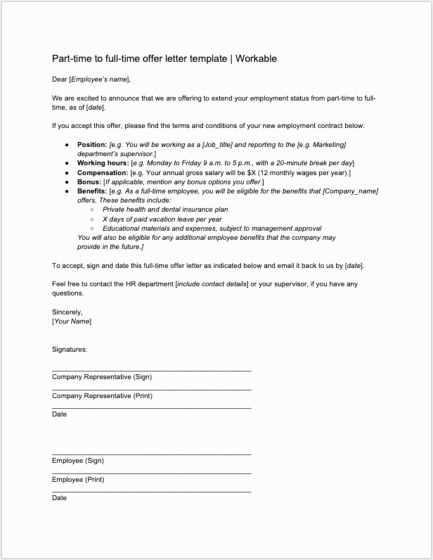
- Ensure part-time employees are paid at least the minimum wage as mandated by law, including for any overtime hours worked.
- Offer benefits in line with legal requirements, which may include health insurance, paid leave, or retirement contributions, depending on the hours worked and local laws.
- Clearly outline wage rates, pay periods, and deductions in the offer letter to avoid disputes later.
Non-Discrimination and Equal Treatment
- Part-time workers are entitled to the same protection against discrimination as full-time employees.
- Ensure that hiring practices are non-discriminatory and based on qualifications, not on status as a part-time employee.
Worker’s Rights and Protections
- Part-time employees are entitled to the same rights as full-time workers, including workplace safety, freedom from harassment, and protection from unfair dismissal.
- Make workers aware of their rights through handbooks or orientation sessions to help ensure compliance with labor laws.
Each job role requires specific details to make the offer letter clear and relevant. Customize the offer letter based on the position to ensure all expectations are addressed accurately.
- For Customer Service Roles: Highlight the working hours, communication expectations, and customer interaction standards. Specify the training period and any performance metrics related to customer satisfaction.
- For Remote Positions: Emphasize the flexibility of work hours, remote collaboration tools, and communication expectations. Include details on time zone coordination and any necessary home office setup assistance.
- For Entry-Level Positions: Focus on the opportunities for growth and mentorship, including any specific training programs or initial tasks that help the new hire adapt to the role.
- For Technical Roles: Include details about project expectations, skill development opportunities, and any specific tools or software the employee will use. Clarify if there are any certifications or qualifications needed during employment.
- For Management Positions: Outline responsibilities in overseeing teams, project management, and budget control. Make it clear if leadership training or specific management tools will be provided.
- For Part-Time Positions: Mention the expected weekly hours, possible schedule flexibility, and any limitations on benefits or vacation days due to the part-time nature of the job.
Adjusting the letter’s language to suit each role ensures that the offer feels tailored and directly relevant to the new hire’s duties and expectations, enhancing clarity and reducing potential misunderstandings.
Part-Time Job Offer Letter Template
When drafting a part-time job offer letter, clarity and detail matter. Ensure that you outline the key aspects of the job to avoid confusion later. Start by confirming the position title and job responsibilities, so the candidate knows exactly what’s expected.
Clear Job Description
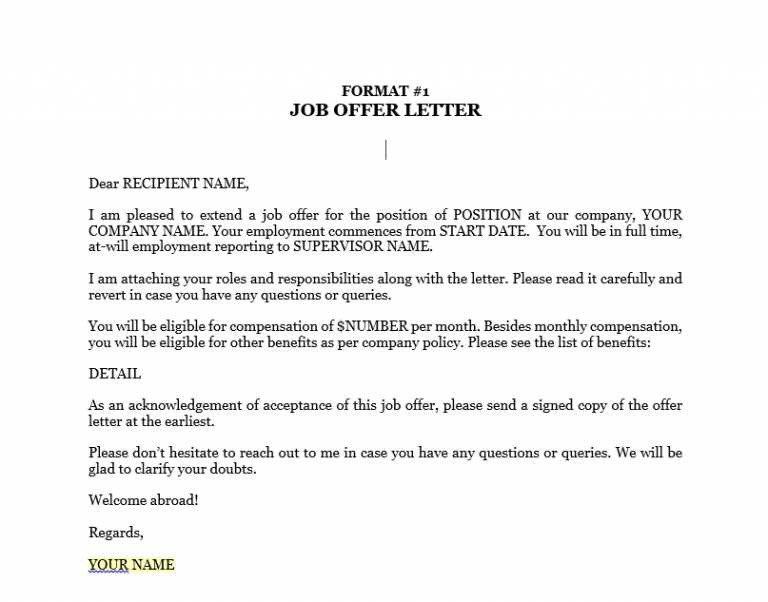
Describe the tasks the employee will be responsible for. Break it down to avoid any ambiguity. For instance, if they will be working as a cashier, include details about customer interaction, cash handling, and operating a register.
Hourly Wage and Work Schedule
Be specific about the hourly wage and expected hours of work. If the role has flexibility, mention the work schedule and any seasonal changes to the hours. A clear expectation helps the candidate plan accordingly.
Providing all the necessary details in the job offer letter reduces confusion and ensures a smoother onboarding process for both parties.